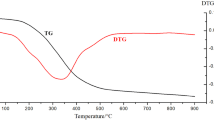Abstract
The effect of sulfur addition/solids content (SA/SC) ratio on heavy metals (e.g. copper, zinc and lead) obtained from mine tailings by indigenous sulfur-oxidizing bacteria was studied, and the changes in the chemical forms of heavy metals after bioleaching were explored. The results show that the solubilization of metals is significantly influenced by SA/SC ratio, and SA/SC ratio of 2.50 is found to be the best for bacterial activity and metal solubilization among six SA/SC ratios tested (such as 1.00, 1.33, 1.50, 1.67, 2.00 and 2.50) under the chosen experimental conditions. The pH decreases fast and the maximum solubilizations of copper and zinc are respectively 81.76% and 84.35% while that of lead only reaches 40.36%. After bioleaching, the chemical forms of heavy metals have changed. The metals remained in mine tailings are mainly found in residual fractions, which is harmless to the surrounding environment.
Similar content being viewed by others
References
WANG Qing-ren, LIU **u-mei, CUI Yan-shan, DONG Yi-ting. Soil contamination and sources of heavy metals at individual sites of industry and mining associate with wastewater irrigation in China [J]. Journal of Environment Science, 2002, 22(3): 354–358. (in Chinese)
PENG Jian-feng, SONG Yong-hui, YUAN Peng, CUI **ao-yu, QIU Guang-lei. The remediation of heavy metals contaminated sediment [J]. Journal of Hazardous Materials, 2009, 161(2/3): 633–640.
SHI Shao-yuan, FANG Zhao-heng, NI **-ren. Comparative study on the bioleaching of zinc sulphides [J]. Process Biochemistry, 2006, 41(2): 438–446.
HE Zhi-guo, ZHAO Jian-cun, LIANG Wan-jie, HU Yue-hua, QIU Guan-zhou. Effect of L-cysteine on bioleaching of Ni-Cu sulphide by A. manzaensis [J]. Journal of Central South University of Technology, 2011, 18(2): 381–385.
PENG Gui-qun, TIAN Guang-ming, LIU Jun-zhi, BAO Qi-bei, ZANG Ling. Removal of heavy metals from sewage sludge with a combination of bioleaching and electrokinetic remediation technology [J]. Desalination, 2011, 271(1/2/3): 100–104.
ZHAO Ling, YANG Dong, ZHU Nan-wen. Bioleaching of spent Ni-Cd batteries by continuous flow system: Effect of hydraulic retention time and process load [J]. Journal of Hazardous Materials, 2008, 160(2/3): 648–654.
CHEN Shen-yi, LIN **-gaw. Bioleaching of heavy metals from livestock sludge by indigenous sulfur-oxidizing bacteria: Effects of sludge solids concentration [J]. Chemosphere, 2004, 54(3): 283–289.
XU Tong-jiang, TING Yen-peng. Optimisation on bioleaching of incinerator fly ash by Aspergillusniger use of central composite design [J]. Enzyme and Microbial Technology, 2004, 35(5): 444–454.
ZHOU Hong-bo, LIU Fei-fei, ZOU Ying-qin, ZENG **ao-xi, QIU Guan-zhou. Bioleaching of marmatite using moderately thermophilic bacteria [J]. Journal of Central South University of Technology, 2008, 15(5): 650–655.
ZHANG Pan-yue, ZHU Yi, ZHANG Guang-ming, ZOU Sai, ZENG Guang-ming, WU Zhen. Sewage sludge bioleaching by indigenous sulfur-oxidizing bacteria: Effects of ratio of substrate dosage to solid content [J]. Bioresource Technology, 2009, 100(3): 1394–1398.
CHEN Shen-yi, LIN **-gaw. Effect of substrate concentration on bioleaching of metal-contaminated sediment [J]. Journal of Hazardous Materials, 2001, 82(1): 77–89.
BOSECKER K. Bioleaching: metal solubilization by microorganisms [J]. FEMS Microbiology Reviews, 1997, 20(3/4): 591–604.
LIU Yun-guo, ZHOU Ming, ZENG Guang-ming, LI **n, XU Wei-hua, FAN Ting. Effect of solids concentration on removal of heavy metals from mine tailings via bioleaching [J]. Journal of Hazardous Materials, 2007, 141(1): 202–208.
LIU Yun-guo, ZHOU Ming, ZENG Guang-ming, WANG **n, LI **n, FAN Ting, XU Wei-hua. Bioleaching of heavy metals from mine tailings by indigenous sulfur-oxidizing bacteria: Effects of substrate concentration [J]. Bioresource Technology, 2008, 99(10): 4124–4129.
ZHOU Li-xiang, FANG Di, ZHOU Shun-gui. Removal of Cr from Tannery Sludge by Acidophilic Thiobacilli [J]. Environment Science, 2004, 25(1). (in Chinese)
MISHRA D, AHN G J, KIM D J, ROGCHAUDHURY G, RALPH D E. Dissolution kinetics of spent petroleum catalyst using sulfur oxidizing acidophilic microorganisms [J]. Journal of Hazardous Materials, 2009, 167(1/2/3): 1231–1236.
WANG Chao, HU **n, CHEN Mao-lin, WU Yun-hai. Total concentrations and fractions of Cd, Cr, Pb, Cu, Ni and Zn in sewage sludge from municipal and industrial waste water treatment plants [J]. Journal of Hazardous Materials, 2005, 119(1/2/3): 245–249.
ZHOU Li-xiang, ZHOU Shun-gui, FANG Di, WANG Shi-mei, WANG Dian-zhan. Mixed pyrite and elemental sulfur to increase the leaching effect of heavy metals in sewage sludge [J], China Environment Science, 2004, 24(1) 110–114. (in Chinese)
APHA. Standard methods for the examination of water and wastewater [R]. 19th ed., American Public Health Association, Washington D C, 1995.
CHEN Shen-yi, LIN **-gaw. Bioleaching of heavy metals from contaminated sediment by indigenous sulfur-oxidizing bacteria in an air-lift bioreactor: Effects of sulfur concentration [J]. Water Research, 2004, 38(14/15): 3205–3214.
Author information
Authors and Affiliations
Corresponding author
Additional information
Foundation item: Project(11JJ2031) supported by the Key Project of Natural Fund of Hunan Province, China; Project(2009SK3029) supported by the Plan of Hunan Provincial Science and Technology Department, China
Rights and permissions
About this article
Cite this article
He, Zb., Liao, T., Liu, Yg. et al. Influence of sulfur addition/solids content ratio on removal of heavy metals from mine tailings by bioleaching. J. Cent. South Univ. 19, 3540–3545 (2012). https://doi.org/10.1007/s11771-012-1440-4
Received:
Accepted:
Published:
Issue Date:
DOI: https://doi.org/10.1007/s11771-012-1440-4




